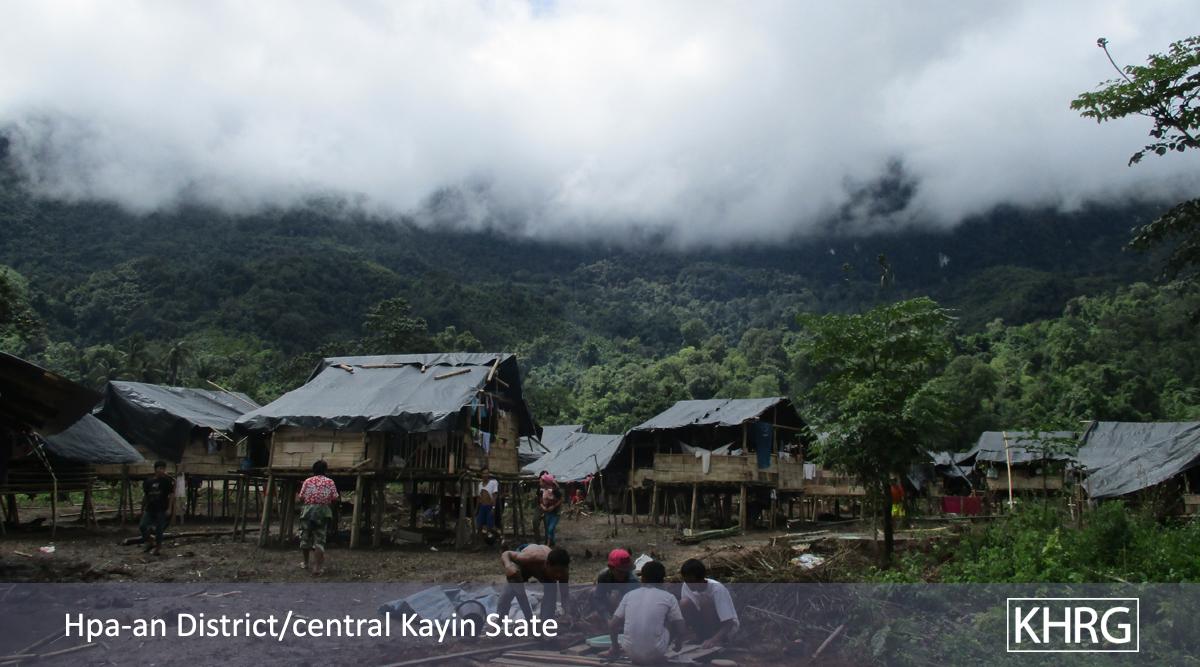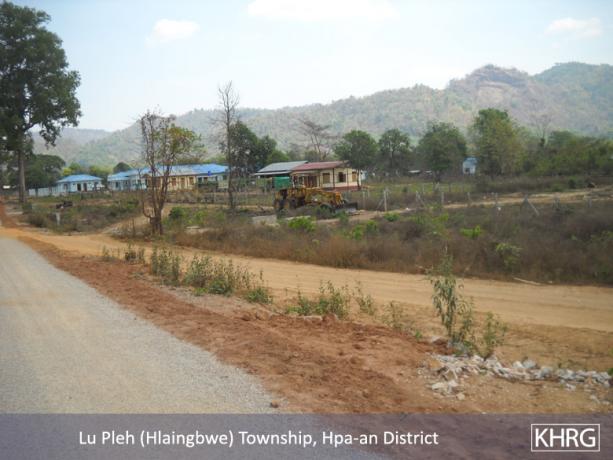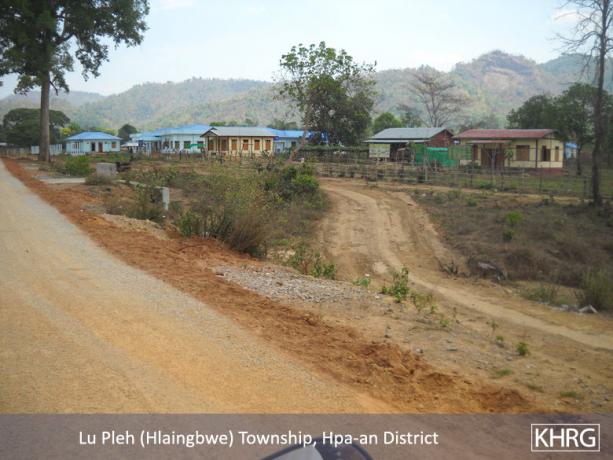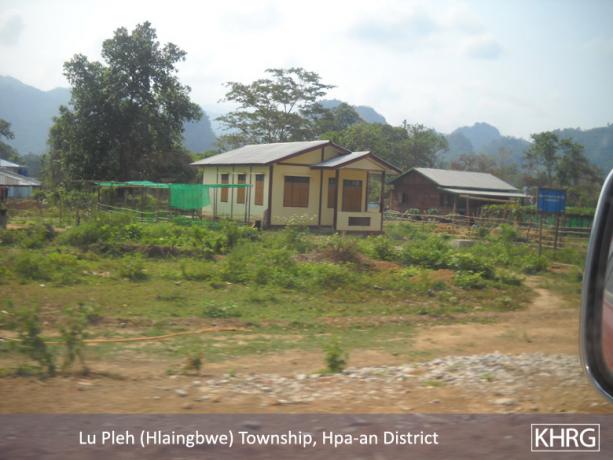This Situation Update describes events and issues occurring in Hlaingbwe Township, Hpa-an District during the period between April and May 2015, including a development project in which the Burma/Myanmar government built a new town on villagers’ lands, as well as healthcare and education updates.
- Between 1981 and 1982, some of the A--- villagers fled to the refugee camps on the Thai-Burma/Myanmar border and left their lands behind. Between 2013 and 2015 the Burma/Myanmar government built a new town on these villagers’ lands and called it A--- Town.
- The Burma/Myanmar government constructed buildings, a road, and army camps on the villager’s lands, limiting the amount of land villagers living there can use to earn a living. Futhermore, A--- village refugees will have no land to build their homes on if they return.
- Due to a lack of employment opportunities in Burma/Myanmar, many young people from Hlaingbwe Township migrate to Thailand in order to find work.
Situation Update | Hlaingbwe Township, Hpa-an District (April to May 2015)
The following Situation Update was received by KHRG in June 2015. It was written by a community member in Hpa-an District who has been trained by KHRG to monitor local human rights conditions. It is presented below translated exactly as originally written, save for minor edits for clarity and security.[1] This report was received along with other information from Hpa-an District, including 130 photographs and three video clips.[2]
Lu Pleh [Hlaingbwe] Township situation update
The Burma government built a new town in Lu Pleh [Hlaingbwe] Township, Hpa-an District which is called A--- Town. In [the place where] B--- and A--- [villages once stood] there are [now] two towns that have been built there. In the past there was only B--- Town but now B--- [Town] separated into a new town which is [called] A--- Town.
In the past, A--- was a village which was located between two mountains in the flat area and there were many farms located there. This village was situated near [the Thai-Burma/Myanmar] border, in the place where most traders would travel through [from Burma to Thailand]. There were [two roads] which were used for trading and they [were called] C--- and D--- roads. Between 1981 and 1982 the Burma government fought with the KNU [Karen National Union] and destroyed the KNU’s road which was used for trading. The road, which is [located] in A--- village, became the Burma government military's [Tatmadaw's] road. The villagers in there could not stand doing forced labour and being porters to transfer [military material for the Tatmadaw] anymore and also [could not stand the] heavy fighting that always occurred in the village. The villagers became refugees in [1981 and 1982]. Due to the fighting [that] took place, some villagers went into hiding in order to earn their living from their farms. Some villagers left their lands behind and fled to C---, D--- [villages in Thailand] and to refugee camps.
Now the Burma government has been establishing a new town [A--- Town], from 2013 to 2015, and they put a lot of effort into it. In [early] 2015, the Burma government established a school, a clinic, and many government departments that are [now] based in A--- Town, are on the villagers’ land. Many different parts [of the villagers’ land] in there are based [being used] by the military. The Burma government constructed many buildings including the Tatmadaw army [camps] on the villagers’ lands and [those lands that were left behind] by the A--- villagers who had migrated to Thailand and refugee camps. If some of them [villagers] came back to their village there [would be] no land for them to build their houses. The government constructed buildings and it lined up houses, [house] by house [in rows]. They planned [had been constructing] a straight road, therefore they destroyed all farm fences [which were in the way of the planned road]. The villagers just kept silent and looked at them. One of villagers said the Tatmadaw [Burma/Myanmar government] built a new town [only] to [be able to] brag [to the people of Burma/Myanmar about what they have done]. They [the Tatmadaw] repaired their army camps, built up many buildings and all of those [were] for the Burma government. They have no concern for the villagers [when it comes to their] economic [situation] and [their access to] education. The Burma government military exploited [all the opportunities and] there are no opportunities for the villagers [to improve their situation]. There is only the opportunity for us [villagers] to do [cultivate] hill fields and farms. We are pleased to do our work [on hill fields and farms] but the Burma government reduced [restricted] the working space [available] to us so it is hard for us [to earn a living].
Civilian situation
Since [the 2012] ceasefire[3] was signed between the Burma government and [the KNU], the local people in Lu Pleh [Hlaingbwe] Township, Hpa-an District are able to work on hill fields and are not afraid of anything [armed groups], therefore in the rice storage there is more rice [collected than before]. Some of them do not have enough rice [food]. The Karen villages which are located in the flat areas have enough food every year and do not need to worry about [food]. Most young people go to work in Thailand because in Burma it is hard for them to find jobs.
Healthcare
The villages which are located in flat [urban] areas have some clinics situated there, but the villages which are located in rural areas have no clinic/health workers’ department in Luh Pleh [Hlaingbwe] Township. The health workers’ departments [found in the urban areas] are from the Burma government and other organisations. The medicines in there are not enough [to supply the population that needs them], therefore if they get a serious disease they have to go to the Lu Pleh [Hlaingbwe Hospital] or Hpa-an [Hospital].
Education
There are two kinds of education [schools] in Luh Pleh [Hlaingbwe] Township, which are the Burma government education [schools] and the KNU education [schools]. The [schools] which are situated in urban areas are the Burma government education [schools]. The [schools] which are situated in local villages most of them [schools] are KNU education [schools].
Armed groups situation
The armed groups which are based in Lu Pleh [Hlaingbwe] Township are Thein Sein government troops [Tatmadaw], KNU’s troops and DKBA [Democratic Karen Benevolent Army][4] Bo Bee’s troops.[5] There is no Karen Peace Council [KNU/KNLA-PC][6] in Luh Pleh [Hlaingbwe] area. They [KNU/KNLA-PC] are usually based along the Salween River in the part near Kyoo Htaw village tract.
Footnotes:
[1] KHRG trains community members in southeast Burma/Myanmar to document individual human rights abuses using a standardised reporting format; conduct interviews with other villagers; and write general updates on the situation in areas with which they are familiar. When writing situation updates, community members are encouraged to summarise recent events, raise issues that they consider to be important, and present their opinions or perspective on abuse and other local dynamics in their area.
[2] In order to increase the transparency of KHRG methodology and more directly communicate the experiences and perspectives of villagers in southeast Burma/Myanmar, KHRG aims to make all field information received available on the KHRG website once it has been processed and translated, subject only to security considerations. For additional reports categorised by Type, Issue, Location and Year, please see the Related Readings component following each report on KHRG’s website.
[3] On January 12th 2012, a preliminary ceasefire agreement was signed between the KNU and Burma/Myanmar government in Hpa-an. Negotiations for a longer-term peace plan are still under way. For updates on the peace process, see the KNU Stakeholder webpage on the Myanmar Peace Monitor website. For KHRG's analysis of changes in human rights conditions since the ceasefire, see Truce or Transition? Trends in human rights abuse and local response since the 2012 ceasefire, KHRG, May 2014.
[4] The Democratic Karen Benevolent Army (DKBA), formerly the Democratic Karen Buddhist Army, was formed in December 1994 and was originally a breakaway group from the KNU/KNLA that signed a ceasefire agreement with the Burma/Myanmar government and directly cooperated at times with Tatmadaw forces. The formation of the DKBA was led by monk U Thuzana with the help and support of the State Law and Order Restoration Council (SLORC), the name of the military government in Burma/Myanmar at that time. For more information on the formation of the DKBA, see "Inside the DKBA," KHRG, 1996. The DKBA now refers to a splinter group from those DKBA forces reformed as Tatmadaw Border Guard Forces, also remaining independent of the KNLA. As of April 2012, the DKBA changed its name from "Buddhist" to "Benevolent" to reflect its secularity.
[5] Bo (Officer) Bee commands the Kloh Htoo Lah which is one of the three current DKBA Battalions, the others being Kloh Htoo Wah and Kloh Htoo Baw, that were formed in September 2011 and refused to transform into Tatmadaw Border Guard battalions. Kloh Htoo Baw (Golden Drum) referred to the DKBA before 2011, but was then reconfigured to have the two additional battalions as well. DKBA forces in Hpa-an and Dooplaya districts that refused to transform into Tatmadaw Border Guard battalions began fighting Tatmadaw forces in November 2010 and have been variously referred to as DKBA #907, Kloh Htoo Baw, Golden Drum, and Brigade #5.
[6] The KNU/KNLA Peace Council (also called the Karen Peace Council or KPC), is an armed group based in Htoh Gkaw Ko, Hpa-an District, which split from the Karen National Union (KNU) in 2007 and subsequently refused to comply with orders from the then-SPDC government to transform its forces into the Tatmadaw Border Guard.












